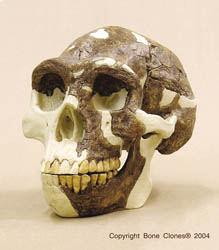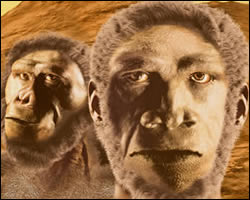Millennium Man Is Missing
Posted by: Loren Coleman on June 11th, 2009
Is there any mystery in paleoanthropology as compelling as the riddle of what happened to the bones of Peking Man?
In 1923-27, prehistoric human fossils were found during excavations of the Zhoukoudian (Chou K’ou-tien) cave system just outside of Beijing, China, which was called Peking back then. Thus they were and continue to be called the “Peking Man” fossils. They were initially classified as Sinanthropus pekinensis and Pithecanthropus pekinensis.
Today, Pithecanthropus pekinensis and Sinanthropus pekinensis are considered examples of Homo erectus.

The original reconstruction of Peking Man was prepared by Dr. F. Weidenreich and Mrs. Lucille Swan in 1937 from the fossil remains of several different individuals found in the caves at Zhoukoudian, China. The Bone Clones replica of the Peking Man is easily obtainable today.
But where are the originals?
One of the most enduring enigmas of paleoanthropology is “What happened to the Peking Man?”
Fossils of Peking Man were placed in the safe at the Cenozoic Research Laboratory of the Peking Union Medical College. Eventually, in November 1941, secretary Hu Chengzi packed up the fossils so they could be sent to USA for safekeeping until the end of the war. They vanished en route to the port city of Qinghuangdao. They were probably in possession of a group of US marines whom the Japanese captured when the war began between Japan and the USA.
Various parties have tried to locate the fossils, but so far they have been without result. In 1972, a US financier Christopher Janus promised a $5,000 (USD) reward for the missing skulls; one woman contacted him, asking for $500,000 (USD) but she later vanished. In July 2005, the Chinese government founded a committee to find the bones to coincide with the 60th anniversary of the end of World War II. They remain missing.
There are various theories of what might have happened, including a theory that the bones sank with the Japanese ship Awa Maru in 1945.
Now comes word that a similar mystery, involving bones of contention, may be forming on the horizon, in Africa.
The so-called “Millennium Man” was one of the most exciting fossil human finds of recent years. So-called because it was discovered in 2000, the Millennium Man is said to be one of those important pieces of the puzzle in understanding human evolution. The team that found these fossils in 2000 was led by Brigitte Senut and Martin Pickford from the Muséum National D’histoire Naturelle.
Orrorin tugenensis is considered to be the second-oldest known hominin ancestor that is possibly related to modern humans and is the only species classified in genus Orrorin. The name was given by the discoverers who found Orrorin fossils in the Tugen Hills in the Baringo District of Kenya’s Rift Valley.
By using radiometric dating techniques, the volcanic tuffs and lavas, faunal correlation and magneto-stratigraphy, the strata in which the fossils were found were estimated to date between 6.1 and 5.8 million years ago, during the Miocene. This find is important because it is possibly an early bipedal hominin.
But have the fossils of the Millennium Man, the only known representative of an ancient and important family, Orrorin, gone missing?
The Daily Nation of Kenya reported as much recently.
Orrorin tugenensis, the Millennium Man fossils, had been kept in a community museum in Kipsaraman Village since 2000, but were removed recently when the museum closed.
Community Museums of Kenya (CMK) Director Eustace Kitonga said the fossils are stored in a secret bank vault in Nairobi, and that only he had the safe deposit box number.
But on May 26, 2009, the National Museums of Kenya said it does not know where the fossils are.
Dr. Mzalendo Kibunja, Kenya’s director of museums, sites and monuments, said unscrupulous businessmen could secretly be pocketing millions of shillings from the fossils by hiring the fossils out to learning institutions.
“Being the only discovered [hominin] fossil at the site, the Orrorin tugenensis is very expensive. There must be a lot of money exchanging hands here,” Kibunja added.
French researcher Martin Pickford, who was behind the research at Kipsaraman, said he was shocked to hear that the fossils had been transferred to a bank in Nairobi. “CMK should return the fossils. What was the need of constructing the museum?” Pickford asked in an e-mail to The Daily Nation.
Kipsaraman Councillor Vincent Kipkata has demanded swift action: “We call on the Community Museums of Kenya to return the fossils. They are our natural resources and we need to have them back.”
Unmentioned in the news out of Kenya is the fate of other important fossils found in those same Tugen Hills.
Less than a half decade ago, the only chimpanzee fossils known to science were unearthed in Kenya, the journal Nature reported. Three 545,000-year-old chimp teeth were dug up in the country’s Tugen Hills, the US discoverers announced. The teeth were excavated from the Kapthurin Formation of the Tugen Hills late in 2004.
The University of Connecticut researcher Sally McBrearty’s comment at the time is chilling in the context of the recent news out of Kenya. She remarked, “I actually suspect there may be [unacknowledged chimp fossils] lurking in museum collections.”
The question today is, how safe are ancient hominin and chimp fossils in some museums in Kenya?
Images above ~ except for the Peking Man skull reconstruction ~ are various artists’ interpretations of the Millennium Man.
About Loren Coleman
Loren Coleman is one of the world’s leading cryptozoologists, some say “the” leading living cryptozoologist. Certainly, he is acknowledged as the current living American researcher and writer who has most popularized cryptozoology in the late 20th and early 21st centuries.
Starting his fieldwork and investigations in 1960, after traveling and trekking extensively in pursuit of cryptozoological mysteries, Coleman began writing to share his experiences in 1969. An honorary member of Ivan T. Sanderson’s Society for the Investigation of the Unexplained in the 1970s, Coleman has been bestowed with similar honorary memberships of the North Idaho College Cryptozoology Club in 1983, and in subsequent years, that of the British Columbia Scientific Cryptozoology Club, CryptoSafari International, and other international organizations. He was also a Life Member and Benefactor of the International Society of Cryptozoology (now-defunct).
Loren Coleman’s daily blog, as a member of the Cryptomundo Team, served as an ongoing avenue of communication for the ever-growing body of cryptozoo news from 2005 through 2013. He returned as an infrequent contributor beginning Halloween week of 2015.
Coleman is the founder in 2003, and current director of the International Cryptozoology Museum in Portland, Maine.














Most people in Kenya (I am part Kenyan and just came back from Nairobi) are thankfully not to bothered about bone shards found in the dirt.
Or about hit and miss dating methods.
Or about the inherent circularity of the geoligic column.
Or about all the things stated in blind faith about human origins.
Lakini wanapenda mungu! Na nyama ya choma!
Well, thanks for stopping by Terrell H. King. BTW, was there a particular reason for your visit other than venting about your frustrations with science?? LOL.
I’ve studied history, wildlife biology and dabbled in geology and am acquainted with the scientific method. I can tell you that science is still administered by fallible and sometimes agenda driven human beings. That means:
1) Data will sometimes be misinterpreted
2) Data will sometimes be deliberately ignored
3) Data that seems obvious to some will be missed by others
4) Data is sometimes impossible to interpret until other pieces of the puzzle are deciphered first.
Don’t believe me? In many scientific circles there are various camps built around certain theories or interpretations. Go to a conference or symposium where papers are presented and you often hear the presenters “slash and burn” alternative viewpoints. This is why scientific theory and interpretations are constantly changing and now thanks to technology those changes occur more rapidly than ever. Even old data and artifacts are being reexamined and new interpretations emerging. Being extremely dogmatic, even with a “scientific fact” could eventually turn out to be a tenuous position. I don’t disdain science or the scientific method, I merely advocate being alert to the potential flaws and changing interpretations that I noted above.
As for losing stuff, consider that war generally produces chaos even in a non-combat zone. A real miracle would have been for these fossils to have survived and gotten safely out of China.
Even in the best of circumstances, artifacts sometimes go missing from museums or field expeditions. For example, a set of George Washington’s dentures were stolen from the Smithsonian in 1976, not an easy feat to pull off. Near my home in 1968, the remains of a mammoth were found during road construction. Evidence showed the bones had been cut and charred which was significant (someone ate him). The bones were photographed, packed in plaster and retrieved by the University of Illinois. No one can find them today. Maybe a janitor said “what are these chunks of plaster all over the place?” and hauled them off to a dumpster. Or maybe they are still in crates in corner of a boiler room covered with mechanical junk. Who knows?
Remember the conclusion of “Indiana Jones and the Raiders of the Lost Ark” when the ark is packed off to oblivion in a massive government warehouse? There is more truth in that than many people realize. Some of the recent dynamic dinosaur discoveries are coming not from bones being excavated in the field, but the bones collected decades ago and “rediscovered” in existing collections.
Could it be …. The Mummy IV — Curse of the Orrorin! 😉
Hey Cliff,
I wasn’t stopping by, I’m pretty much a cyber resident – I’m at this site most days waiting for the next titbit from Mr Coleman.
Sorry for the venting, I love cryptozoology, but I dislike certain popular theories stated as fact (That isn’t directed at you Loren), and I guess to point out the flaws in them is a hobby of mine.
Alligator, my sentiments exactly on the fallibility and agendas of some scientists.
Oh, forget to mention…
Isn’t it funny how there’s always a picture of these slightly human looking bipedal apes getting whipped by some sort of predator?
The monkeys in the trees must be laughing at them!
So much for natural selection when you have X amount of predators waiting for an ape’s toes to start becoming less opposable, so that they start walking on the ground more frequently and can’t climb so good anymore – dinner!
Terrell H King: Or until they put on boots, as the case may be!
The middle picture looks a little too much like an Egyptian god, with the body of a man and the head of an animal. Not as cool a god as Sobek, though.
Alligator- You bring up something that I have brought up at Cryptomundo before. The “Raiders of the Lost Ark Warehouse Effect.” Indeed many fossils that are touted as amazing new discoveries are actually pieces that were already stored away and only appreciated when they were re-examined or accidently rediscovered years later. Some of these finds have been basically just stumbled upon in old museum collections and had slipped under the radar since they were either not previously recognized for what they were, were mislabeled, or misplaced. People might be surprised by just how often this happens.
There are no doubt very important finds lurking in dusty storeroom corners, or even under a pile of junk in a boiler room. 🙂 I often find myself speculating as to whether we actually already do have concrete fossil evidence for sasquatch or other cryptids boxed up in some museum basement somewhere.
It must be also noted that there is a chance these fossils are gone for good. Sometimes things are stolen, destroyed, or in some cases plain old thrown out. Consider the case of PhD student Daniel Bennet. The guy spent five years toiling in the jungles of the Philippines collecting around 35 kg of feces from the rare butaan lizard. It was the largest, most complete dietary record for this rare animal ever compiled, and what happened? The whole thing was accidentally thrown away by a lab technician. Why? Because it was apparently not marked correctly. Museum personnel, scientists, and yes, lab technicians are not perfect. Mistakes happen.
Whether through greed, carelessness, oversight, or even sheer stupidity, it is unfortunate yet inevitable that some amazing finds are going to vanish.
Sounds like a religious agenda to me. Think about it. The Vatican alone likes to keep important information locked away.